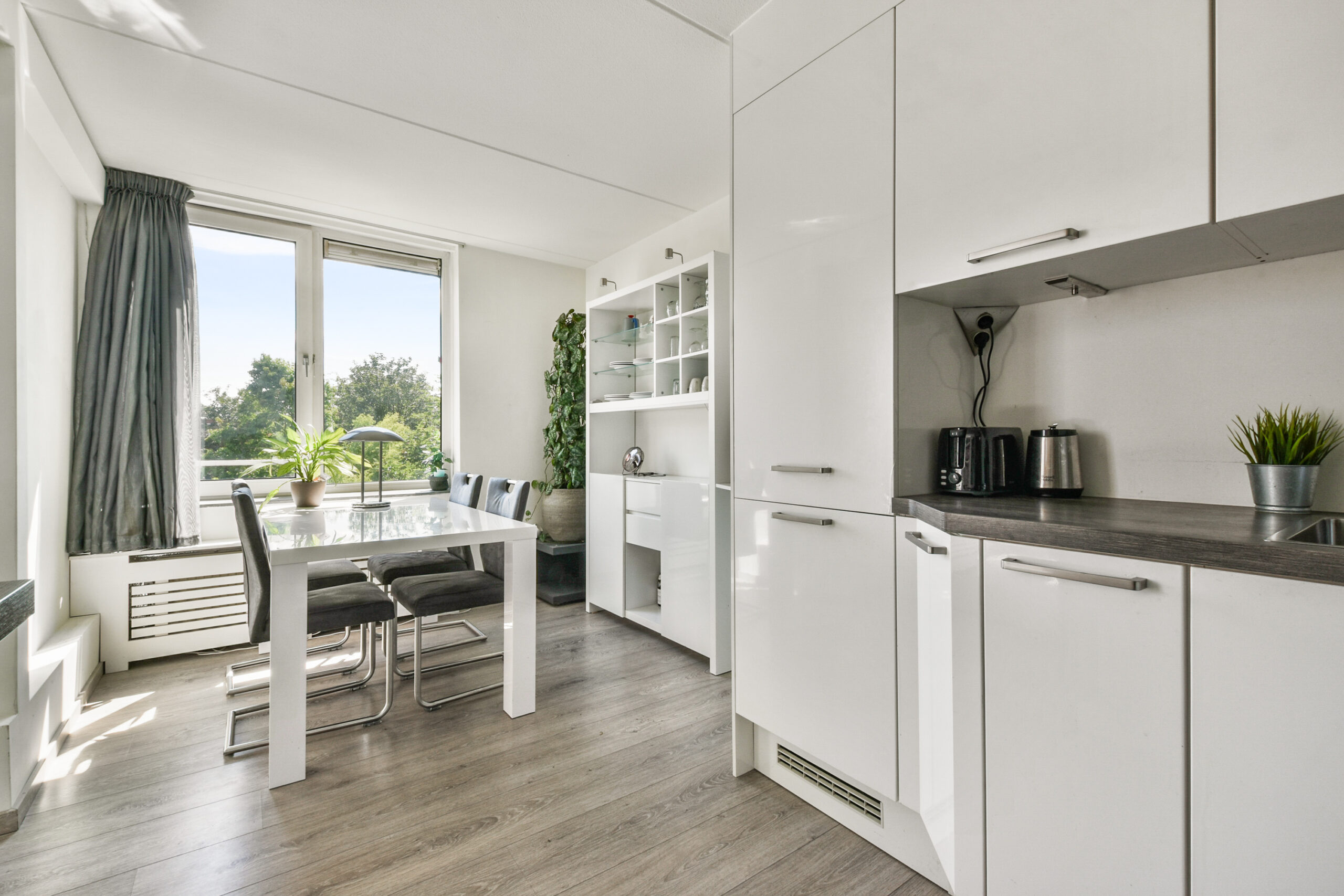Open kitchen tips are some of the few key points that home owners can follow if they are looking to implement this style in their home space. Here are 5 ultimate tips that may be beneficial to home owners.
Open Kitchen Tips #1: Having A Simple And Minimal Design

Smoothing out an open kitchen concept in your house can be perfectly done with minimal design. Simplicity lies at the heart of minimalism and will leave the space light and uncluttered. Start with neutrals such as white, beige or pale grey — shades will help the kitchen blend in with the surrounding spaces. For cabinetry, handleless or flat-panel designs are great since they are sleek and trendy. Avoid awkward details which might give an overdose of an open concept — it is time for smooth and streamlined surfaces which will be in character with the order and calm.
For a functional yet minimal space, an integrated appliance will sit flush with the cabinetry — removing the clutter of visual distraction. Maximise storage to keep countertops clean by using smart solutions for pull-out drawers or hidden storage in an island. This keeps essential kitchen tools out of sight, contributing to the overall tidy look.
@ampquartzcabinets Your kitchen is the heart of your home – even if you don't technically own that home. But just because you're renting doesn't mean you have to settle for a drab and dingy kitchen. Looking for ways to upgrade your kitchen and still get your security deposit back? Watch til the end! #AluminiumCabinets #6GAluminiumCabinet #HomeDecorMalaysian #kitchendesign #KitchenCabinets #KitchenCountertops #KabinetDapurJohor #KabinetDapurJB #KabinetDapurUluTiram #KitchenCabinetJohor #AMPQUARTZ
♬ wannabe intoxicated – That Guy
The lighting to a minimalist open kitchen is indeed important. Layered lighting including recessed ceiling lights and pendant lighting over the island or bar helps add functionality without overwhelming the space with too much form. Emphasise natural light by minimising window treatments so the sun can create a bright and inviting atmosphere.
With a few simple decorative touches such as a plant or small piece of art, a sense of warmth can be invoked without sacrificing the minimalist ambience. Such touches should be delicate and unobtrusive so as not to overpower the area. Last but not least, furniture is functional and sleek, with clean lines that reinforce the minimalistic style. A properly selected dining table or kitchen island could serve both as a focal point and a functional one, helping to create a balanced and clutter-free open kitchen.
Open Kitchen Tips #2: Defining The Zones Within The Space

Defining zones within an open kitchen is very important for it to remain functional but still retain that openness and airy feel. Because the open kitchen does not have the structure of walls separating the kitchen from either a living or dining area, you can create a natural flow from room to room by strategic design elements.
Placement of furniture is probably one of the most effective ways of defining zones. For example, a dining table can also serve as a dividing line between the kitchen and the living room — one can distinguish which area is the kitchen and which part is the living room. Similarly, in cases when there is no wall to separate the living room area from the kitchen space, one may still demarcate the transition with a sofa or a bookshelf placed at the edge of the kitchen area.
Others prefer targeting zone establishment by using rugs or different types of flooring. A rug under the dining table or in the living space can visually separate it from the kitchen space — a slight change in the type or pattern of flooring can also emphatically stress the functional difference between the zones. For example, using tile in the kitchen area and hardwood in the living space provides both a practical and aesthetic separation.
Light can also create different zones. Pendant lights over a bar or kitchen island top can make the workspace of the kitchen stand out while the dining or living area feels cosy and apart with ambient light. Finally, addition of a breakfast bar or kitchen island is one of the versatile methods for delineating the zone while it offers supplementary seating, storage or a casual dining area. These few subtle design strategies will create distinct zones within the area of an open kitchen and will keep the space organised and cohesive.
Open Kitchen Tips #3: Ensuring The Use Of Space Is Efficient

Designing an open kitchen at home demands efficiency in space to maintain its functionality along with making the space beautiful. First of all, a fluid layout where the flow between the kitchen, dining and living is absolutely smooth should be contrived. This space and openness might be facilitated by choosing an L-shaped or U-shaped kitchen. A great way to focus on space efficiency would be through using a central island or even breakfast bar. Besides giving more counter surface for food preparation, it also serves as a dining area or at least a casual one for social interactions.
Since the development of an open kitchen is prone to clutter to destroy a cohesive look, storage options are a must. Provide vertical storage such as tall cabinets or floating shelving that keep things organised and off countertops to maintain a clean, open space. Multifunctional furniture such as an island that includes storage built-in can help optimise use in the kitchen even more.
@ampquartzcabinets Tips menabung dengan sepantas kilat untuk install cabinet dapurrr!!!🚨 Korang shopping je dengan kitorang, kita bagi 𝗜𝗻𝘀𝘁𝗮𝗹𝗺𝗲𝗻𝘁 𝗣𝗹𝗮𝗻 𝗨𝗽 𝘁𝗼 𝟮𝟰 𝗠𝗼𝗻𝘁𝗵𝘀😜 📞Call kita untuk sebarang pertanyaan okie: https://go.wa.link/ampquartz 📍Datang je serbu showroom kita kat 82, Jalan Gaya 1, Taman Gaya, Ulu Tiram, 81800 Johor Bahru atau korang Waze je https://waze.com/ul/hw23bfh9s4 #tipsjimatduit #ampquartz #kitchencabinet #ampquartzkitchencabinetmaker #customcabinetJohor #CabinetUluTiramJohor
♬ original sound – O.r.d.i.n.a.r.y – • Ji-Ai-Es-Bi-Ba-Bi •
Making use of the natural light is another great way to enhance that feeling of space. Large windows or glass doors can help in giving the kitchen a big and open space. Adding this to planned lighting such as under-cabinet or recessed lighting illuminates the work areas without cluttering the room with bulky lighting fixtures.
Finally, consistent flooring and a unified colour palette in the open space create the smoothest possible transitions from one zone to another. This will not only make your kitchen seem more spacious but also a harmonious blend of all its elements. A prudent goal is an open kitchen that is functional, cosy and beautiful which effectively merges with the entire house.
Open Kitchen Tips #4: Including Aspects Of Personalisation

Personalisation makes the open kitchen individualistic to your way of living and taste. Probably, the easiest way you can personalise your open kitchen would be through colour schemes and materials that resonate with your style. Depending on whether you prefer a sleek, modern look or a warm, rustic feel, the selection of hue and finish can bring harmony from your kitchen into the rest of your living space. Other ways to inject some personality are through custom cabinetry and countertops. You are able to go with marble, quartz or even wood to complement your overall design feature. With open shelving, the added ability to display cookware, plants or art brings character to the room.
Lighting options also offer fabulous opportunities for customisation. From hip pendant lights over the kitchen island to subtle recessed lighting, the style of lighting one installs can help determine the mood of one's kitchen. A statement dining table or breakfast bar can blur the lines between kitchen and living space with functional yet stylish furniture. The large island with seating can also become a social focal point — perfect if you love to entertain.
You can add personal touches such as framed photos or unique artworks to give a warm sensation in the kitchen or an assembly of your favourite cookbooks for that feel. Other than adding texture, you can incorporate elements like wood, metal or fabrics with rugs, cushions or curtains that go with the open-plan design. These customisations will ensure that the kitchen is not just a functional area but personalised to make it an inviting space that reflects you.
Open Kitchen Tips #5: Putting Together Materials That Work Well

Coordinating materials will be essential to create a seamless, harmonious look from the kitchen into the adjoining living areas of the home. First of all, select regular flooring within the open areas. This will help make the kitchen coherent with either the dining or living spaces will make fluid the transition between these rooms. Materials such as wood, tile and luxury vinyl are great choices for this effect. You can also use area rugs to define zones within the open layout subtly without interrupting the flow altogether.
Choose cabinetry finish that reflects the look of the rest of your home. Choose between matte and glossy and make sure the colour and texture will work with the furniture in the adjacent rooms. Neutral-coloured open kitchens are very popular. White, beige or light grey tone works together in harmony.
@ampquartzcabinets Replying to @semut kecil Renovate Satu Rumah Siap!! Assalamualaikum dan Selamat Sejahtera 🥰 Alhamdulillah, selesai pemasangan cabinet untuk seluruh rumah. Kita pasangkan tuan rumah ni Modern style Dry kitchen, Wet kitchen, TV Console, Wardrobe untuk Master Bedroom, Custom Wardrobe/bookshelf, Hallway Cabinet, Vanity Cabinet dan juga Laundry Cabinet😘 Perfecttt👍 📞Hubungi kami untuk sebarang pertanyaan: https://go.wa.link/ampquartz 📍Jemput datang ke showroom kami: https://waze.com/ul/hw23bfh9s4 82, Jalan Gaya 1, Taman Gaya, Ulu Tiram, 81800 Johor Bahru #ampquartz #johor #kitchenrenovation #ampquartzkitchencabinetmaker #customcabinetJohor #CabinetUluTiramJohor
♬ Cidro Vs Kluthuk – Waru Leaf
Countertops are another key material decision. When possible, match or coordinate the surfaces in the living or dining room to create continuity. For instance, using the same type of stone such as quartz or granite can really tie two rooms together nicely.
Backsplashes offer the opportunity to incorporate texture without overpowering a room. Choose tiles, glass or other materials that reflect the tone or pattern echoed elsewhere in the room such as in cushions or rugs to create continuity. In so doing, you will come up with a highly integrated open kitchen concept that will merge organically into your home and sustain both style and functionality.





